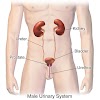 |
Techniques to study kidney functions and visualise urinary tract structures and processes have been highly developed in recent years. Very accurate knowledge of the condition of urine can be obtained with the help of highly sophisticated instruments, chemical analysis, X-ray visualization and function tests.
urine analysis
Urine inspection diagnosis is an ancient and venerable practice, practiced centuries ago by the Babylonian Maggi and the Chinese, Hindu, Greek, and Roman physicians of the time. In Medieval times, urine masks were held in high regard by patients and doctors and physicians made diagnoses only by inspecting fluids.
Today, a properly analyzes urine sample can tell many accurate stories about physical conditions. A complete urinal is not always necessary; It depends on what the doctors want to learn about the condition of a particular patient. For example, a volume of urine in 24 hours can be significant. Smell and color are macro-qualities, and hazardous color does not always have a scary meaning, as red colored urine indicates too much beet ingestion. Tests for sugar, albumin, specific gravity and acid-alkaline reaction are more or less routine, but more sophisticated to determine the presence of more types of inorganic crystals, bile, pus, blood cells, bacteria, proteins, and other elements . . Trial orders may be given. . Cultures may be necessary to identify the particular germs responsible for urinary tract infection, so that effective microbial drugs can be used against them. The urinal alone does not tell the whole story about a patient's condition.
Cystoscopy
With the introduction of the catheter, a urinary tract device, it was a breakthrough for modern Cystoscopy. This remarkable device essentially consists of a hollow tube, at the end of which is a small electric bulb, which can be inserted into the bladder. Various lens display systems are then introduced. In this way, the internal parts of the bladder, ducts and urethra can be visually inspected.
Modern cystoscopes are highly versatile devices that adopt sophisticated corrections. Cystoscope forms can be used as operative devices to destroy tumors and remove stones and foreign bodies from the bladder. Recent improvements in lighting systems have made it possible to visualise the ureter and renal pelvis, and it is likely that excellent devices will be developed to inspect urine collecting chambers within the kidney.
X-ray
The development of X-ray equipment has greatly improved the study of kidney function and urinary tract. Plain X-rays can now be performed that show the outline of urinary tract structures. Other details can be seen by injecting the radiopaque material and making an X-ray film that performs the Pylogram. This allows visualization of the entire urinary tract and reflects any pathology or changes associated with disease processes. It is also possible to project these areas into specialized areas through a cystoscope and catheter. Recent developments in Cinefluorography make cinematic action of the urinary tract possible after the introduction of opaque media.
Since the main function of the kidneys is to clean certain substances from the blood, their ability to do so measures the function of the kidneys. Very specific studies of the kidney's ability to clean blood chemicals and dyes and other substances provide important information about how well the organs are performing their work.







